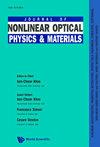Photonics design theory enhancing light extraction efficiency in quantum dot light emitting diodes
IF 2.3
4区 物理与天体物理
Q2 OPTICS
引用次数: 1
Abstract
The external quantum efficiency (EQE) of quantum dot light emitting diodes (QLEDs) needs improvement for more power-efficient devices. One of the main limitations is the low light extraction efficiency (LEE). Generally, only 20% of the light that is generated inside the emissive layer makes its way out of the device into air, with the rest being lost to waveguide and substrate modes and surface plasmon polaritons. Different photonics structures have been previously tested to help extract the light that is trapped inside the device. Here we report a photonics design which is a combination of nanopillars and grating structures for improving the LEE of QLEDs. The effect of changing the nanopillar height, radius and material has been studied. It was found that ZnO nanopillars of 500 nm pitch, 200 nm height and 400 nm width alongside 150 nm width and pitch grating structure can increase the LEE at 460 nm by 50% and at 640 nm by 20%. It was also found that different materials can help extract light at different wavelengths. TiO2 nanopillars increased the extraction efficiency at ∼590 nm region which was not observed by the other materials. As around 19% of the world’s electricity consumption is due to lighting applications, increasing the LEE can significantly reduce the power consumption.提高量子点发光二极管光提取效率的光子设计理论
量子点发光二极管(qled)的外量子效率(EQE)需要提高,以实现更节能的器件。其中一个主要的限制是低光提取效率(LEE)。一般来说,在发射层内部产生的光中,只有20%的光会从设备中进入空气中,其余的光会流失到波导和衬底模式以及表面等离子激元极化中。之前已经测试了不同的光子学结构,以帮助提取被困在设备内部的光。本文报道了一种结合纳米柱和光栅结构的光子学设计,用于改善qled的LEE。研究了改变纳米柱高度、半径和材料对纳米柱的影响。结果表明,采用500 nm间距、200 nm高度和400 nm宽度的ZnO纳米柱,加上150 nm宽度和间距的光栅结构,可使460 nm处的光电致光率提高50%,640 nm处的光电致光率提高20%。研究还发现,不同的材料可以帮助提取不同波长的光。TiO2纳米柱提高了~ 590 nm区域的萃取效率,这是其他材料没有观察到的。由于全球约19%的电力消耗是由于照明应用,因此增加LEE可以显着降低电力消耗。
本文章由计算机程序翻译,如有差异,请以英文原文为准。
求助全文
约1分钟内获得全文
求助全文
来源期刊
CiteScore
3.00
自引率
48.10%
发文量
53
审稿时长
3 months
期刊介绍:
This journal is devoted to the rapidly advancing research and development in the field of nonlinear interactions of light with matter. Topics of interest include, but are not limited to, nonlinear optical materials, metamaterials and plasmonics, nano-photonic structures, stimulated scatterings, harmonic generations, wave mixing, real time holography, guided waves and solitons, bistabilities, instabilities and nonlinear dynamics, and their applications in laser and coherent lightwave amplification, guiding, switching, modulation, communication and information processing. Original papers, comprehensive reviews and rapid communications reporting original theories and observations are sought for in these and related areas. This journal will also publish proceedings of important international meetings and workshops. It is intended for graduate students, scientists and researchers in academic, industrial and government research institutions.

 求助内容:
求助内容: 应助结果提醒方式:
应助结果提醒方式:


